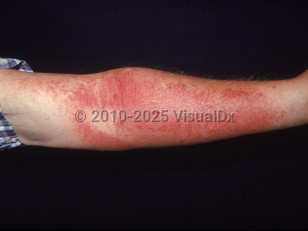Emergency: requires immediate attention
Recluse spider envenomation in Child
Alerts and Notices
Important News & Links
Synopsis

The brown spiders, Loxosceles species, are found in temperate and tropical latitudes around the world. They live indoors and outdoors in dark areas where they build messy webs. Recluse spiders are most abundant and active at night during the warm months, are non-aggressive, reclusive, and prefer to retreat when threatened. Loxosceles spiders are typically brown in color, measure 2-3 cm from leg to leg, and have 6 eyes arranged in 3 pairs (most spiders have 4 pairs). The brown recluse spider Loxosceles reclusa has a characteristic dark, violin-shaped spot on the dorsal aspect of the cephalothorax.
Envenomation by Loxosceles species (loxoscelism) can result in dermonecrosis and, less commonly, a potentially fatal systemic illness that includes hemolysis and rhabdomyolysis, with subsequent renal failure. Loxosceles venom contains cytotoxic, proteolytic, coagulopathic, and hemolytic components. The primary toxic component is sphingomyelinase D, which is largely responsible for necrosis and hemolysis. Hyaluronidase causes the characteristic gravitational spread of the lesion.
The North American brown recluse (L. reclusa) is the most common Loxosceles species responsible for human injury. The Chilean recluse venom (Loxosceles laeta) is the most toxic and poses a serious public health threat in South America. Envenomation causes several deaths per year in South America. Death is extremely rare in the United States.
Brown spider bites typically occur during dressing or sleeping when spiders become trapped in clothing or bed linens. The bite can produce a sharp, stinging sensation, although frequently the victim is unaware of having been bitten. The spider is rarely seen. Characteristic of Loxosceles envenomation, severe burning pain and pruritus develop at the bite site within 2-6 hours. Over time, the wound typically develops an erythematous halo surrounding a central hemorrhagic vesicle. Occasionally, the central vesicle will be surrounded by an area of ecchymosis, surrounded by a ring of pallor and an outer ring of redness. By day 3 or 4, the hemorrhagic vesicle becomes necrotic, and an eschar forms. After 2-5 weeks, the eschar sloughs, leaving an ulcer that often heals by secondary intention, though some may require skin grafting. In severe cases, there can be progressive tissue necrosis that is particularly severe in fatty regions such as the buttocks or thighs.
The incidence of systemic involvement varies by species and geography and is more common in children. Loxosceles reclusa of North America rarely causes systemic symptoms, while systemic involvement is not uncommon with the South American L. laeta. As early as 24 hours after envenomation, fever, arthralgias, nausea, vomiting, diarrhea, rash, myalgias, and headache can develop. With more severe systemic illness, hemolysis is the predominant feature. Thrombocytopenia, disseminated intravascular coagulopathy, proteinuria, renal failure, and death have been reported.
Envenomation by Loxosceles species (loxoscelism) can result in dermonecrosis and, less commonly, a potentially fatal systemic illness that includes hemolysis and rhabdomyolysis, with subsequent renal failure. Loxosceles venom contains cytotoxic, proteolytic, coagulopathic, and hemolytic components. The primary toxic component is sphingomyelinase D, which is largely responsible for necrosis and hemolysis. Hyaluronidase causes the characteristic gravitational spread of the lesion.
The North American brown recluse (L. reclusa) is the most common Loxosceles species responsible for human injury. The Chilean recluse venom (Loxosceles laeta) is the most toxic and poses a serious public health threat in South America. Envenomation causes several deaths per year in South America. Death is extremely rare in the United States.
Brown spider bites typically occur during dressing or sleeping when spiders become trapped in clothing or bed linens. The bite can produce a sharp, stinging sensation, although frequently the victim is unaware of having been bitten. The spider is rarely seen. Characteristic of Loxosceles envenomation, severe burning pain and pruritus develop at the bite site within 2-6 hours. Over time, the wound typically develops an erythematous halo surrounding a central hemorrhagic vesicle. Occasionally, the central vesicle will be surrounded by an area of ecchymosis, surrounded by a ring of pallor and an outer ring of redness. By day 3 or 4, the hemorrhagic vesicle becomes necrotic, and an eschar forms. After 2-5 weeks, the eschar sloughs, leaving an ulcer that often heals by secondary intention, though some may require skin grafting. In severe cases, there can be progressive tissue necrosis that is particularly severe in fatty regions such as the buttocks or thighs.
The incidence of systemic involvement varies by species and geography and is more common in children. Loxosceles reclusa of North America rarely causes systemic symptoms, while systemic involvement is not uncommon with the South American L. laeta. As early as 24 hours after envenomation, fever, arthralgias, nausea, vomiting, diarrhea, rash, myalgias, and headache can develop. With more severe systemic illness, hemolysis is the predominant feature. Thrombocytopenia, disseminated intravascular coagulopathy, proteinuria, renal failure, and death have been reported.
Codes
ICD10CM:
T63.331A – Toxic effect of venom of brown recluse spider, accidental, initial encounter
SNOMEDCT:
40119006 – Poisoning due to brown recluse spider venom
T63.331A – Toxic effect of venom of brown recluse spider, accidental, initial encounter
SNOMEDCT:
40119006 – Poisoning due to brown recluse spider venom
Look For
Subscription Required
Diagnostic Pearls
Subscription Required
Differential Diagnosis & Pitfalls

To perform a comparison, select diagnoses from the classic differential
Subscription Required
Best Tests
Subscription Required
Management Pearls
Subscription Required
Therapy
Subscription Required
References
Subscription Required
Last Reviewed:05/14/2017
Last Updated:06/05/2017
Last Updated:06/05/2017
Emergency: requires immediate attention
Recluse spider envenomation in Child

